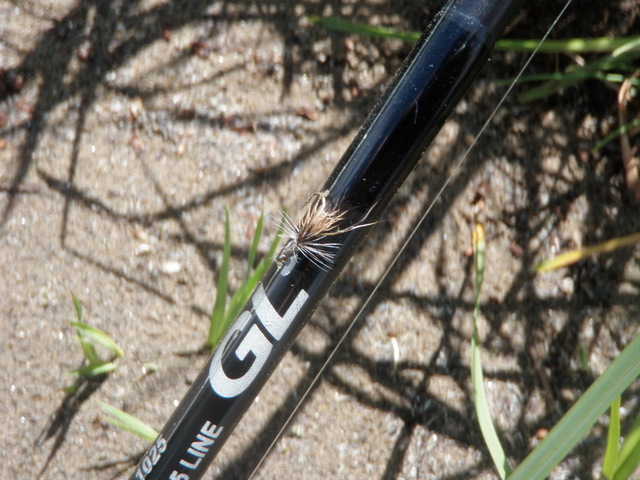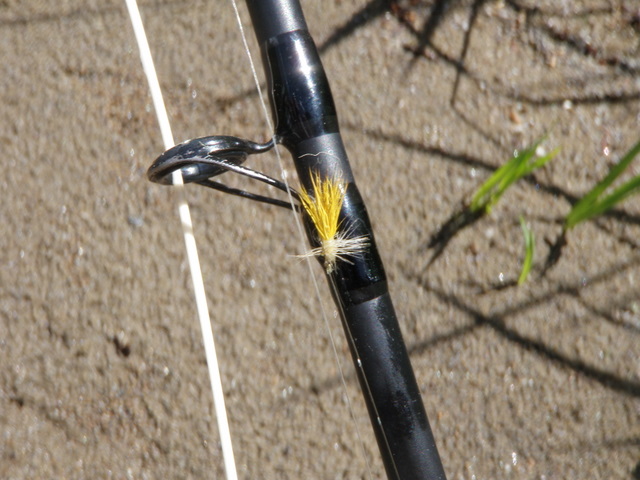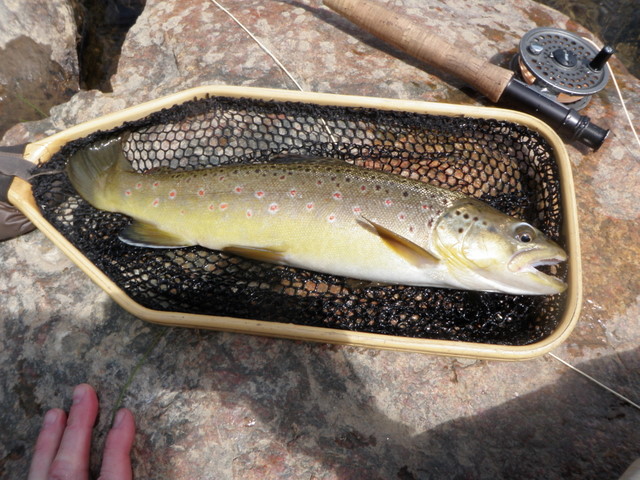7/29/10
10:00AM – 3:30PM
Breeze Access near Parshall
7 Trout
Colorado River 07/28/2010 Photo Album
I had such great success on the Colorado River last year that I don’t want to miss any in 2010. For this reason, I elected to drive two hours to the Colorado at Parshall on Thursday. A week ago I had a reasonable day, but the main PMD hatch had not kicked in yet. My notes from the previous two years told me that it was the end of July when I hit the dense PMD hatches.
I arrived nice and early and was on the river by 10AM. There was only one other car in the parking lot at the Breeze access, but the mosquitoes were still present. I put my waders on to protect my legs, then lathered up with copious amounts of DEET. As I was gathering my fishing gear to take off for the river, I noticed a fly rod and reel lying on the ground at the edge of the parking lot near where I’d parked. It didn’t look broken and there wasn’t any identification, so I picked it up and placed it in the back of the van.
I headed straight to my go to place…the long pool with a deep main current nearly down the center. This time there were no other fishermen present. I had the whole area to myself. It remained partly cloudy, but sunnier than the areas I’d driven through such as Winter Park and Fraser. I tied on a yellow sally and light gray caddis (see photos above) and began prospecting the area roughly in the middle of the long pool where the run fanned out in a nice deep riffle. No fish were showing interest, and I didn’t see any surface activity whatsoever. I decided to rig up with an indicator and a pair of nymphs and go deep along the seam next to the strong main current. I snagged and ripped off the split shot and a pair of flies. I decided to persist and rigged up again, and this time caught a small brown 10-11 inches long. I continued fishing the entire left side of the current until I reached the top of the run, then returned to mid-pool and found a stump to sit on while I ate my lunch. I observed the water and began to see some rises, and two fish showed themselves several times.
I finished my lunch and pulled the insect repellant from my backpack and lathered up once again. Could these rises be the beginning of a PMD hatch? I tied on the money fly, the light gray comparadun. After quite a bit of casting to multiple rises, a 13 inch brown sucked in the comparadun. After releasing the fish, I tried to interest the remaining sporadic risers in the comparadun, but they weren’t fooled. Perhaps fish were rising at the tail of the pool similar to the previous Thursday? I fought my way through the tall grass to the very tail of the pool and did notice a few very sporadic rises. I wasn’t seeing any PMD’s (I only saw a total of two), but did spot some yellow sallies and occasional caddis. I tied on the yellow sally/olive caddis double. I began more or less prospecting since the rises had long ceased, and on a cast directly upstream around 10-15 feet and 5 feet out from the bank, a trout slashed at my flies. I set the hook and a strong battle ensued. I eventually landed the brown and photographed. It was quite a net-filler and extended from the tip of the net to the beginning of the handle (see photo below).
Amazingly, both flies were in the large brown’s mouth. Did it take both flies or did one just work into its mouth during the battle? We’ll never know the answer to that. The brief hatch appeared to be over, and I didn’t want to go deep again, so I decided to cross the river slowly and carefully and walk up the right bank and search for telltale rises. I waded the very edge of the river on the right side to avoid going into the vegetation and create a mosquito swarm. Amazingly I didn’t spot any rises in the juicy right pool from the center current over to the bank. I waded the entire edge and prospected at a couple places without consequence.
When I arrived at the head of the run, I decided to continue working my way up the river prospecting the riffles in the same manner that I’d done a week ago with the yellow sally and caddis. Once again the skies were darkening, and after I’d fished out one section of angled riffles, I waded to the shore and put on my raincoat. I continued working my way and managed to land three additional browns prospecting in this manner. Two grabbed the yellow sally and one took the caddis. When I got to the spot where I’d quit and exited to the path and then the bridge a week ago, I decided to explore the water between me and the bridge. There always seemed to be fishermen there, so I guessed it was attractive water.
By now the wind was gusting and I could hear thunder but still distant. The attractive water appeared just below a small island where the wide shallow channel on my side merged with a swifter but narrower channel coming from the left. The two merged and created a nice little deeper slower area right in front of me. The skies opened and I pulled my hood up over my head and wore my western hat on top of the hood. It was effective but surely not fashionable. The rain pelted the river for three to five minutes, and I paused for part of the time. When the rain slowed to a steady shower, I noticed the swallows were working and skimming the water occasionally. I looked closely and several fish were working the water near me. One was a decent sized rainbow that cruised back and forth not more than eight feet above me occasionally sipping something. I couldn’t see any PMD’s or caddis on the water. What could they be eating? I stared at the water intently for several minutes and spotted a small mayfly spinner close to 16-18. It had a green body, not dark olive or light yellow/green, but green.
I looked in my fly boxes that contain some of the flies I tied for Pennsylvania and spotted the cornuta spinners. These were actually a bit too large and bit too dark green, but I didn’t have many options. I tied one on and began casting. It was very difficult to follow the fly in the dim light among rain dimples and some broken current. I think I had a couple looks from the rainbow but no take. But on one cast when I couldn’t find my fly, I went to lift and recast and felt weight and hooked a decent brown. I landed the 13” fish and removed the cornuta spinner from the upper lip.
I fished the spinner a bit longer, but as quickly as the spinner fall had commenced, it ended. The area that was alive with fish sipping spinners for fifteen minutes or so was now totally dead. The rain had now dwindled to drizzle, and I moved up closer to the junction of the currents. I went back to the yellow sally and caddis and prospected some attractive water for a bit, but found no action. I was now quite close to the bridge and feeling chilled, so I found the path and exited the river. The mosquitoes were swarming me as I crossed the bridge and hiked to the highway. I had to pause along the shoulder of route 40 and remove my backpack and apply more DEET.
I debated circling back through the lot and then heading back to the river again, but decided I was quite chilled and tired. I removed the rod I’d found when I got back to the car and discovered it was an Orvis four piece 6 weight. The section holding the reel was stuck to the first section part way apart. The reel was a Reddington reel and there was nice fly line in it. I decided to take it home and see if I could separate the sections using ice like I’d done with my old Sage once before.
As I drove back along the river on route 40, I looked down at the river and noticed a stream of brown water on the right side. Apparently it had stormed quite a bit somewhere and washed a bunch of sediment into the river. The decision to leave when I did was looking pretty good.



